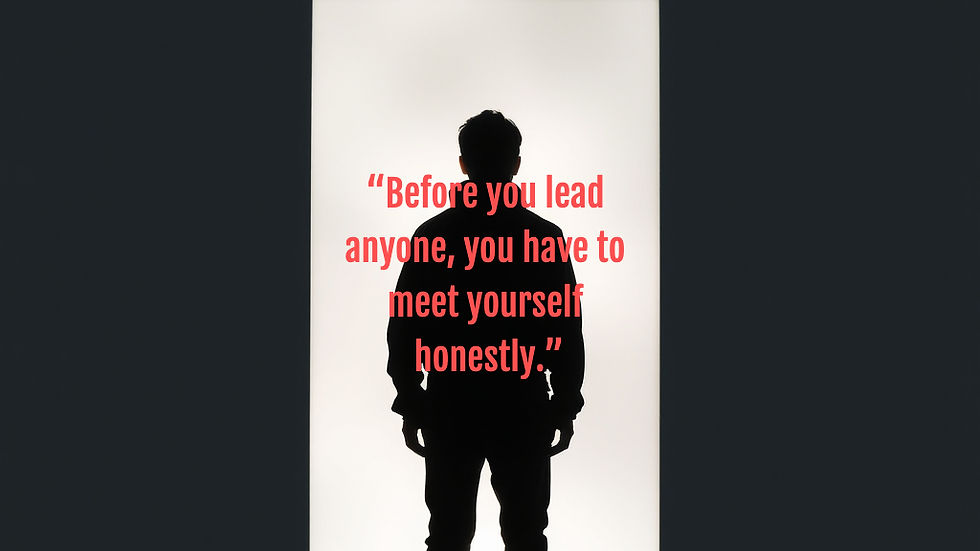Identity Before Influence
- Kamohelo Makwela
- Oct 19
- 3 min read
An exploration of self-awareness as the foundation of leadership. Before we lead teams, we must lead ourselves — the person behind the title, before the performance.
Inspired by The Story of Coconut — leadership begins where identity is reconciled.

The Mirror Before the Microphone
Before you pick up a mic, step into a meeting, or give direction to anyone else — you have to face yourself first.
Most people skip that part. We’re obsessed with the how of leadership: how to motivate, how to manage, how to influence. But rarely do we ask the most important question — who is the person doing the leading?
Because until you know that, you’re just playing a role.
We see it all the time — confident professionals who crumble when stripped of title. Leaders who can inspire a team but can’t face their own reflection. It’s not that they’re bad people; they just built influence before they built identity.
Before you can lead anyone else, you have to stop lying to yourself.
The Performance Trap
The modern workplace rewards performance over authenticity. We’ve built systems that applaud what looks good, not what’s real.
We say all the right things — “purpose,” “vision,” “empowerment” — but many of us don’t believe half of what we say. We’ve learned the script of leadership without the story behind it.
We promote people for competence, not character. And then we wonder why influence feels hollow.
It’s easy to play leader. It’s harder to be one.
You can fake charisma, but you can’t fake character.
Identity is what you do when no one is watching — and what you won’t do even when everyone is watching.

The Cost of Disconnection
The gap between who we are and who we perform to be is exhausting. That’s where burnout lives. Not in workload — in pretending.
Many leaders aren’t tired because of what they’re doing; they’re tired because of what they’re suppressing. They spend their days wearing composure like armor, trying to hold it all together while slowly losing sight of themselves.
Influence built on pretense collapses under pressure.
When you lose yourself, your leadership becomes reaction, not direction. You start chasing validation instead of vision. You start managing perception instead of people.
And the worst part? The team can feel it — they can always tell when the leader isn’t home inside themselves.
The Story of Coconut
When I wrote The Story of Coconut, it was never just about resilience or reinvention — it was about identity. It’s the story of peeling back layers to return to what’s true, even when it’s uncomfortable.
In leadership, that process never ends. You don’t arrive at self-awareness once and stay there. You keep rediscovering who you are as you grow.
The challenge is this: can you keep evolving without losing your essence?
Leadership isn’t about becoming someone new. It’s about remembering who you were before the world told you who to be.
Every great leader I’ve met had one thing in common — a brutally honest relationship with themselves. They didn’t outsource their reflection to compliments or performance reviews. They did the inner work, even when it got ugly.
Identity as a Strategy
Here’s the truth: self-awareness isn’t a “soft skill.” It’s a strategic advantage.
When you know your values, your boundaries, and your blind spots — you make faster, wiser decisions. You communicate with clarity. You stop leading from insecurity and start leading from integrity.
Teams don’t need perfect leaders. They need anchored ones. People don’t follow confidence; they follow consistency.
The most powerful message you’ll ever deliver is the way you live.
Identity doesn’t just shape how you speak — it shapes how you show up, how you decide, and how you recover when things fall apart.

Coming Home to Yourself
Leadership is not a performance to master — it’s a person to meet.
The goal isn’t to find the right leadership model. It’s to find the real you behind the model. Because that’s where authenticity lives. That’s where trust is built. That’s where influence begins.
The world doesn’t need more leaders who know what to say — it needs more leaders who know who they are.
And that starts long before the boardroom, the meeting, or the title. It starts in the mirror — before the influence, before the applause, before the mask.
It starts with identity.


